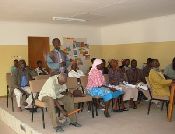 |
The dissemination strategy for this study site identifies a number of different target audiences to whom information and results from the project can be addressed. The contents of messages, the format in which they are delivered and their expected impact vary from one audience to another. |
| Location |
Global |
| Message |
The DESIRE approach to assessment, mitigation and monitoring of land degradation is effective but may have challenges in specific contexts. |
| Product format |
- Two peer-reviewed in Land Degradation & Development publications that are in press, namely Reed et al and Perkins et al. These will be published this year i.e. 2011.
- Four DESIRE special issue publications under preparation
- Two MSc. dissertations
- One undergraduate dissertation
|
| Details, dates and locations of products |
- Reed et al. (2011) in Land Deg. & Dev 22.
- Perkins et al. (2011) in ibid.(early view)
- Planned special issue publication journals: Env Mgt; Catena; Land Deg. & dev.
- MSc. Dissertations (2008/2009) on DESIRE website and with Univ. of Wageningen
- BSc dissertation (2010) on DESIRE website & with Univ. of Wageningen
|
| Method of dissemination |
Peer-reviewed journal outlets |
| Expected impact |
- Reed et al. (2011) has already been cited by 22 scholars.
- Land Degradation & Development has an impact factor of 1.33.
|
| Location |
National |
| Message |
Recommendations on how to empower Boteti land users to implement viable prioritized mitigation strategies against deforestation and and overgrazing. |
| Product format |
- Posters on 2 themes: a) solutions to overgrazing challenge in the Boteti area; b) alternative land use to cattle industry in the Boteti – a CBNRM approach of game ranching as suggested by stakeholders. (NB: CBNRM is Community Based Natural Resource Management); c) dissemination of DESIRE work to media
- Policy brief on biogas & communal game ranching as strategies against deforestation and overgrazing.
- Land users’ video
- Fact sheet on improving communication between researchers and the media.
|
|
Details, dates and locations of products
|
»Policy brief
»Interviews with local residents
Posters: Oct 2011
»Factsheet 5: Improving communication
|
| Method of dissemination |
E-mail postings; DESIRE-HIS |
| Expected impact |
Positive feedback (commendations); requests for advice on biogas production. |
| Location |
Local (Boteti) |
| Message |
That local knowledge was valuable in identifying land degradation issues and their mitigation. |
| Product format |
- Hold 2 workshops, that would be poster and PowerPoint dominated: a) progress with the biogas technology and; b) launching of the biogas plant.
- Develop Setswana (local language) posters and policy brief.
- Policy brief and Posters for traditional leaders (Dikgosi i.e. chiefs; and for schools).
|
|
Details, dates and locations of products
|
- Boteti workshops: Sept 2011; January 2012.
- Posters & policy brief: Sept & Dec 2011 and Jan 2012.
|
| Method of dissemination |
Participatory workshops
|
| Expected impact |
Workshop proceedings indicated that land users greatly appreciated the DESIRE approach and biogas experiment. |
|




